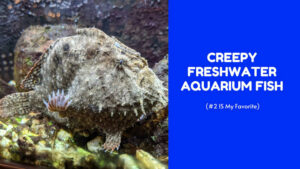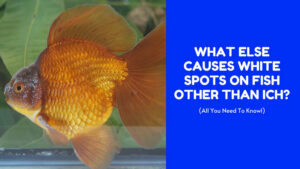Fish, like their keepers, are highly susceptible to diseases and infections.
And we understand that seeing your “fin-friends” in distress is not something you’d want to face. But the good news is that there are several medications to treat them.
You might have heard about Pimafix and Melafix, but as a beginner, it’s easy to get confused between them. So, here we are with a guide on Pimafix vs. Melafix.
What Are Pimafix?
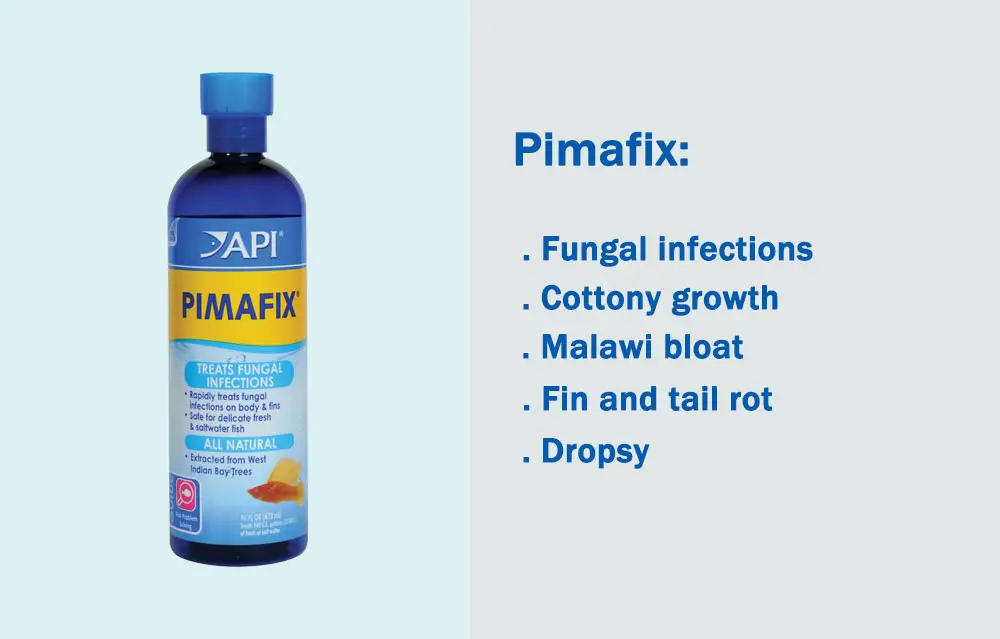
Pimafix is an all-natural medicine for fish that is made from a special extract derived from the West Indian Palm trees. Most fish keepers prefer Pimafix as it doesn’t interfere with the color or pH of the water and is safe for plants and reefs. It may help treat conditions like:
- Fungal and cotton-like growths
- Internal and external bacterial infections
- Discoloration (reddening) of fins
What Does Pimafix Treat?
Open Red Sores
Open red sores on the fish’s body can be indicative of ulcers caused by Aeromonas or Pseudomonas (bacterial infection). And their red color is often attributed to the red abscess or the red edges.
In more severe cases, the ulcer may become very large and expose the muscles underneath. Moreover, these open sores may lead to other problems like fin rot or a decrease in appetite and overall activity.
Fin And Tail Rot
Fin and tail rot are generally caused by bacterial infections, which are triggered when the fish’s immune system is trying to deal with other illnesses. Increased stress within the tank due to overcrowding, fluctuating water conditions, and lack of maintenance can make the immune system weak, thereby causing fin and tail rot.
The common physical symptoms of this disease include:
- Physical deterioration of the fins and tail
- Sudden gaps and faded color in the fins or tail
In addition, the fish may experience inflammation near the base of the fin.
Open Body Wounds
Open body wounds occur when the fish hit the sharp edges of rocks or stones in a state of panic or when they are injured by other fishes. Although they are easily treatable, unattended wounds can harbor fungal or bacterial infections.
Eye Cloud, Pop Eye, Body Slime, And Mouth Fungus
While an eye cloud (or clouded cornea) usually occurs in both eyes from a bacterial infection, a pop eye can be unilateral or bilateral. It may look like the eyes are about to pop out of the socket and can be caused by bacterial infections or injuries.
However, body slime is primarily caused by parasites and results in an abnormally high secretion of mucus by the fish’s body. It commonly appears as cloudy patches along the flanks and may make the fish susceptible to other diseases.
Although the name may suggest otherwise, mouth fungus may appear in other body parts of the fish like the head, face, gills, jaws, and even fins. It appears as off-white or grey patches in the affected areas and may turn into ugly-looking lesions or sores in severe cases.
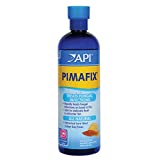
- Contains one (1) API PIMAFIX Antifungal Freshwater and Saltwater Fish Remedy 16-Ounce Bottle
- Rapidly and safely treats fungal infections on body and fins of fish
- Contains all-natural extract from West Indian Bay Trees to help with fungus and cottony growth
- Helps heal internal and external bacterial infections in freshwater, saltwater and reef aquariums
- Use daily for a week when treating infections
What Are Melafix?
Melafix, which is pretty similar to Pimafix, is generally prepared from different species of tea trees, which is generally administered to freshwater and saltwater aquarium fish. It helps them fight off various gram-positive and gram-negative bacterial infections, which may cause:
- Cottonmouth or mouth fungus
- Fin rot and tail rot
- Eye cloud
- Exophthalmia or pop-eye
What Does Melafix Treat?
Fungus Or Cottony Growth
Cotton-like growths in fish are caused by fungi, usually around open wounds or damaged scales and spread to the rest of the body. However, they may also affect the healthy fish living in unclean water saturated with waste and other decaying organic compounds.
Besides, fish with suppressed immunity may fall prey to this disease.
Mouth And Body Fungus
Mouth and body fungus in fish may appear as gray patches on the affected parts of cotton-like growths and are promoted by poor water conditions. Not only that, but they may also be caused by insufficient nutrition or feeding of expired readymade fish food.
Reddening Of Fins And Body
Red spots on a fish’s fins or body and the general appearance of a reddish hue may result from a bacterial infection caused by the bacterium cyprinicida. Primarily caused by poor water conditions that weaken immunity, this disease may also be accompanied by increased body mucus production and clamped or closed fins.
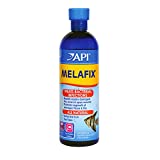
- Contains one (1) API MELAFIX Freshwater Fish Bacterial Infection Remedy 16-Ounce Bottle
- Heals bacterial infections and repairs damaged fins, ulcers and open wounds
- Contains natural, botanical tea tree extract to quickly and rapidly help fish
- Helps treat newly-introduced fish to reduce risk of disease outbreak in freshwater aquariums
- Use daily for a week when treating infections and for 3 days as a preventive when adding new fish
FAQs
What Is The Difference Between Melafix And Pimafix?
As we have already mentioned before, both these fish treatments have natural ingredients and work in a similar manner. However, Melafix is said to be more effective for bacterial infections, while Pimafix may help with bacterial and fungal infections alike.
Interestingly, the recommended dosage for both Pimafix and Melafix is the same- adding 5ml of the liquid to every 10-gallon of water for at least seven consecutive days. Once this period is over, change 25% of the water and continue with the same dose for another week or two if required.
You may see some foaming in the water on adding them to the aquarium, but rest assured that the formulations won’t alter the state of the water or affect the biological filtration system.
Is Melafix And Pimafix Safe For Snails, Bettas, Beneficial Bacteria, Shrimps, And Plants?
Both Melafix and Pimafix, when used in the proper doses, are considered safe for use in aquariums with snails, bettas, shrimps, plants, and beneficial bacteria. However, they contain certain chemicals that aren’t safe for humans. So, don’t use them to treat fish meant for human consumption.
Can Melafix And Pimafix Be Used Together?
Yes, Melafix and Pimafix can be combined to treat stubborn or serious bacterial or fungal infections. Moreover, you can use them at the recommended doses, i.e., 5ml of each per 10-gallon of water.
Final Thoughts
On that note, we will conclude today’s guide.
Just because you have effective medications on your side doesn’t mean that you can do away with caring for the fish. In fact, many diseases and infections can be prevented with proper care and maintenance.
But before we leave, here’s something to remember: if these medications don’t help your fish within 10 to 14 days, get in touch with a veterinarian.


